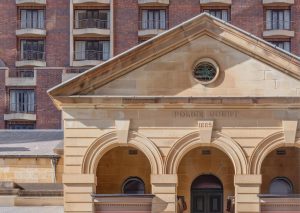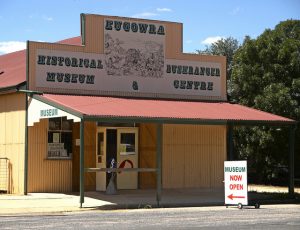Bailed up 1895, 1927
Tom Roberts (England; Australia, b.1856, d.1931). Oil on canvas, 134.5 x 182.8 cm Art Gallery of NSW. Purchased 1933. Photo: AGNSW #833
There are a number of stories that exist around Australia’s most famous gold robbery. The Escort Rock Gold Robbery is an incident in our history that inspired Tom Roberts to paint his iconic work ‘Bailed Up’. It’s also a story that’s told by many a bushranger devotee and several of our museums, including the Justice and Police Museum and the lesser-known Eugowra Museum. And it’s a story with a write-your-own ending.
Of the robbery itself, several things can be confirmed: that on a cold winter’s afternoon in 1862, the gold escort coach coming from Forbes trundled down a hill 5 kilometres out of Eugowra on its way to Bathurst. The coach, laden with banknotes and the weight of 14,000 pounds of freshly dug gold from the goldfields, slowed to pass a bullock team on the road. There, from behind a rock Frank Gardiner and his gang of first-time-bushrangers shouted ‘Bail up’ and proceeded to shoot at the four police troopers on board the coach.
The horses reared, the coach toppled over and the troopers fled. The gold-hungry boys absconded with their heavy bounty and took off towards their hide-out some 80 kilometres away in the Weddin Mountains.
At this point in steps a reluctant hero. Squatter Hanbury Clements heard the shots, rescued the ailing troopers and then, in the black of the night, rode 27 kilometres to Forbes to alert the Police. They assembled quickly and with renowned Aboriginal tracker Jimmy Dargan set off to chase the robbers down.
The horses reared, the coach toppled over and the troopers fled.
The story goes that, in order make a hasty retreat, the bushrangers abandoned the gold intending to return for it once things had quietened down. And here’s where it starts to get interesting–while authorities say most of the gold was eventually recovered local knowledge tells it differently. There are those in the area who say that the gold was not found or at least, not all of it.
Which is why the story continues to attract considerable attention. In 2012 a group of American ‘geologists’ arrived in Eugowra to search for the last of the gold. Word on the ground is they were distant relatives of Gardiner who, after spending 10 years in prison for the crime migrated to California and opened a pub there.
If you are interested in digging up the last of this story, you better head on out to Eugowra. The famous rock is accessible and sits 200 metres above the road on private property. There’s a little gate to pass through and a hike up the hill to the site of the robbery.
A visit to the Eugowra Museum will reveal two weapons used in the robbery; the relics of one reputed to be Johnny Gilbert’s found after many years at the site of the robbery and another thought to belong to Ben Hall.
On the outskirts of town you’ll see a reception centre called Eat your Greens which sits on the site of the creek crossing known as ‘Muddy Gate’—it was here the coach crossed and after the spectacular events of 1862, a Troopers station was established there in an attempt to prevent further robberies. Too little, too late, as the saying goes.
The famous painting by Roberts also sports an interesting history – it was painted more than 30 years after the robbery which indicates the enduring nature of bushranger stories long after the threat of them had gone. Roberts, infatuated with the story, painted the piece en plein air working from a purpose-built cubby house above the road. He employed locals as models and recreated the whole scene, and if you peer very carefully into the scrub you can even see Gardiner’s pack horse tied to a tree in anticipation of the get away.
The painting hangs in the 19th Century Australian Art section in the Art Gallery of NSW. Best of all, it’s free: so why not let yourself get ‘Bailed Up’ by this archetypal Aussie painting?
You might also like:
- More about the robbery.
- Kids audio tour – AGNSW Gallery Channel
- See more about Tom Roberts’ Bailed Up in the AGNSW collection.






